Surfaces presenting α-phenyl mannoside derivatives enable formation of stable, high coverage, non-pathogenic Escherichia coli biofilms against pathogen colonization†
Abstract
Prevention of pathogenic colonization on medical devices over a long period of time remains a great challenge, especially in a high-nutrient environment that accelerates the production of biomass leading to biofouling of the device. Since biofouling and the subsequent pathogen colonization is eventually inevitable, a new strategy using non-pathogenic bacteria as living guards against pathogenic colonization on medical devices has attracted increasing interest. Crucial to the success of this strategy is to pre-establish a high coverage and stable biofilm of benign bacteria on the surface. Silicone elastomers are one of the most widely used materials in biomedical devices. In this work, we modified silicone surfaces to promote formation of high coverage and stable biofilms by a non-pathogenic Escherichia coli strain 83972 with type 1 fimbriae (fim+) to interfere with the colonization of an aggressive biofilm-forming, uropathogenic Enterococcus faecalis. Although it is well known that mannoside surfaces promote the initial adherence of fim+ E. coli through binding to the FimH receptor at the tip of the type 1 fimbriae, it is not clear whether the fast initial adherence could lead to a high coverage and stable protective biofilm. To explore the role of mannoside ligands, we synthesized a series of alkyl and aryl mannosides varied in the structure and immobilized them on silicone surfaces pre-coated with a poly(amidoamine) (PAMAM) dendrimer. We found that stable and densely packed benign E. coli biofilms were formed on the surfaces presenting biphenyl mannoside with the highest initial adherence of fim+ E. coli. These non-pathogenic biofilms prevented the colonization of E. faecalis for 11 days at a high concentration (108 CFU mL−1, 100 000 times above the diagnostic threshold for urinary tract infection) in the nutrient-rich Lysogeny Broth (LB) media. The result shows a correlation among the initial adherence of fim+ E. coli 83972, the coverage and long-term stability of the resulting biofilms, as well as their efficiency for preventing the pathogen colonization.



 Please wait while we load your content...
Please wait while we load your content...